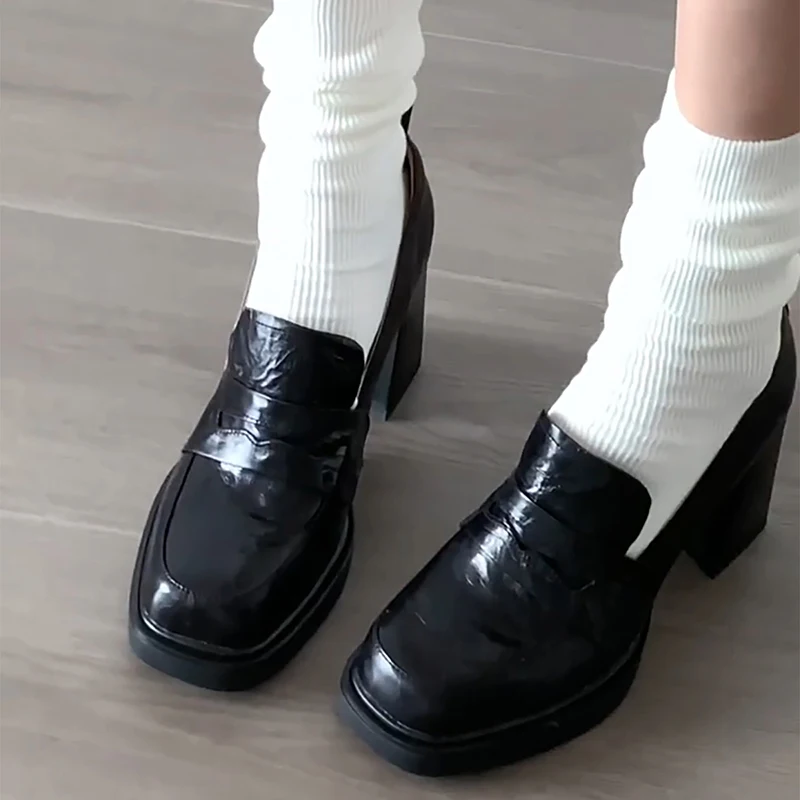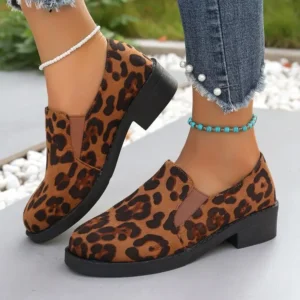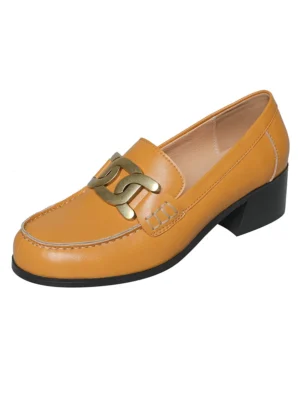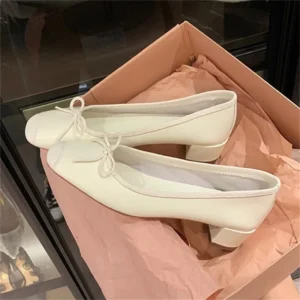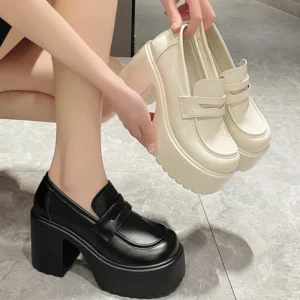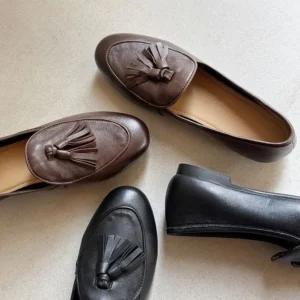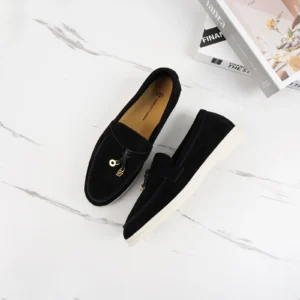Understanding the Appeal of Square Heel Loafers with Structure
Square heel loafers represent a perfect marriage of practicality and style in the footwear world. The square heel itself is characterized by its geometric, right-angled shape that creates a solid foundation beneath the foot. Unlike rounded or tapered heels, square heels distribute weight more evenly across a broader surface area, offering immediate stability with each step. This distinctive shape also provides a clean, architectural aesthetic that stands out in contemporary fashion.
Loafers themselves have a rich history, evolving from purely casual footwear to versatile staples found in wardrobes worldwide. These slip-on shoes typically feature a moccasin-like construction with a separate piece of leather (often called a saddle) across the instep. What began as leisure footwear for country houses has transformed into a sophisticated option appropriate for numerous settings.
When we talk about “structure” in footwear design, we’re referring to the supportive elements that help the shoe maintain its shape and provide stability to the foot. Structured shoes include reinforced counters at the heel, supportive shanks running through the midsole, and carefully engineered insoles that cradle the foot. This structure ensures the shoe retains its intended shape over time while providing crucial support to the wearer.
The combination of square heels with structured loafer design creates footwear that balances comfort, sophistication, and practicality. The women’s square heel loafers available today represent the evolution of this style, offering stability without sacrificing elegance. These shoes have become essential in modern wardrobes because they bridge the gap between comfortable casual footwear and refined professional options.
What makes square heel loafers particularly appealing is their versatility—they can transition seamlessly between workplace settings, weekend outings, and even more formal occasions with the right styling. This adaptability, combined with their distinctive silhouette, has secured their place as both fashion staples and practical investments.
The Engineering Behind Stability: How Structure Enhances Square Heel Loafers
The exceptional stability of square heel loafers isn’t just a matter of aesthetic design—it’s rooted in principles of physics and biomechanics. Square heels distribute body weight more evenly across a wider surface area compared to pointed or rounded heels. This simple geometric advantage creates a more stable platform, reducing pressure on specific points of the foot and creating a natural balance that makes walking more comfortable.
From an anatomical perspective, properly structured footwear provides crucial benefits for foot health:
- Reduces excessive pronation (inward rolling of the foot)
- Prevents overstretching of the plantar fascia
- Minimizes pressure on the metatarsal heads
- Supports the natural arch of the foot
- Promotes proper alignment of the ankle, knee, and hip
Several key internal construction elements contribute significantly to the stability of quality square heel loafers:
Heel Counter Rigidity: A firm, molded component that wraps around the heel, preventing excessive side-to-side movement and keeping the foot properly aligned with the shoe.
Shank Support: The metal or composite piece that runs between the insole and outsole provides crucial torsional rigidity, preventing the shoe from twisting unnaturally when walking.
Insole Construction: Quality structured loafers feature layered insoles with proper cushioning and arch support that conform to the foot’s natural contours.
The relationship between structure and comfort is often misunderstood—many assume that soft, unstructured shoes are more comfortable. However, comfortable walking loafers with proper structure actually provide superior comfort for extended wear by supporting the foot’s natural mechanics and preventing fatigue.
Additionally, proper structure significantly extends a loafer’s lifespan. When shoes lack adequate internal structure, they tend to collapse, crease inappropriately, and lose their shape quickly. The reinforced elements in structured square heel loafers maintain the shoe’s integrity even with regular wear, making them a smart long-term investment despite a potentially higher initial cost.
Material Matters: How Different Materials Affect Structure and Style
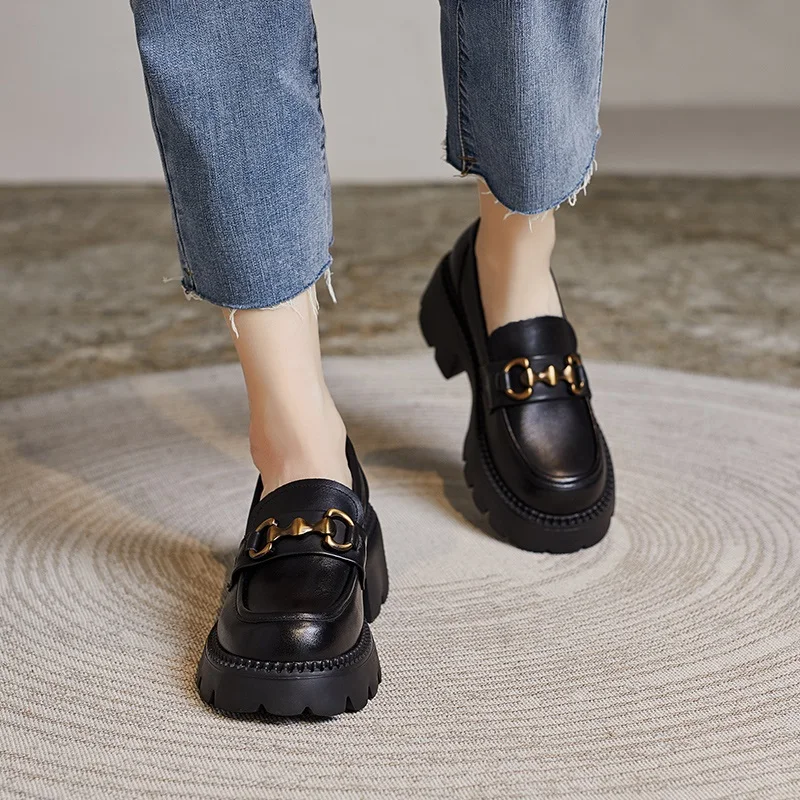
The materials used in square heel loafers dramatically influence both their structural integrity and visual appeal. Understanding these differences helps make informed purchasing decisions for both style and longevity.
Full-grain leather stands as the premier choice for structured loafers. This highest grade of leather preserves the natural grain and inherent strength of the hide. As it ages, full-grain leather develops a rich patina that enhances its appearance rather than deteriorating. The natural fiber structure provides excellent support while molding to the foot over time, creating a personalized fit. Leather heeled loafers offer unmatched durability and timeless appeal when properly maintained.
Patent leather delivers high-gloss sophistication perfect for dressier occasions. This treated leather with its characteristic shine adds visual impact to any square heel loafer. Structurally, patent leather tends to be stiffer than regular leather, which can enhance the shoe’s shape retention but may require longer breaking-in periods. The smooth surface also makes these loafers easier to clean, though they can be more prone to cracking if not properly cared for.
Suede offers textural interest and a softer appearance. While generally more casual than smooth leather, suede can be dressed up or down depending on design. Suede flat loafers provide a different structural feel—they typically mold to the foot more quickly but require more protection against moisture and staining. The napped texture adds visual interest but demands more maintenance to preserve appearance.
Synthetic materials have evolved significantly in recent years. Modern synthetics can closely mimic natural materials while offering benefits like water resistance, consistent texture, and often lower price points. However, they generally don’t breathe as well as natural materials and may not conform to the foot with the same personalized fit over time.
| Material | Durability | Structural Support | Maintenance | Aesthetic Appeal | Best For |
|---|---|---|---|---|---|
| Full-grain Leather | Excellent | High | Moderate | Improves with age | Investment pieces, daily wear |
| Patent Leather | Good | High | Low | High-impact, formal | Evening events, special occasions |
| Suede | Good | Moderate | High | Soft, textural | Casual to semi-formal settings |
| Synthetic | Variable | Moderate to low | Low | Consistent | Budget options, occasional wear |
The material choice significantly impacts not just how the loafer looks but how it performs structurally. Leather and high-quality synthetics hold their shape better over time, while softer materials may require additional internal structure to maintain the shoe’s integrity through regular wear.
Signature Styles: Key Variations of Structured Square Heel Loafers
Square heel loafers come in various distinctive styles, each offering unique aesthetic and functional benefits. Understanding these variations helps in selecting the perfect pair for your needs.
The minimalist square heel loafer represents streamlined sophistication with clean lines and understated design elements. These loafers typically feature:
– Smooth, unembellished uppers
– Precise stitching that follows the shoe’s natural lines
– Monochromatic or tone-on-tone color schemes
– Medium-height square heels (1-2 inches)
– Rounded or slightly pointed toes
This minimalist approach makes these loafers exceptionally versatile, pairing easily with both casual and formal attire.
Statement square heel loafers make a bolder impression through:
– Exaggerated proportions with wider or higher heels
– Distinctive hardware or embellishments
– Contrasting materials or color blocking
– Unique textures or finishes
– Architectural heel designs that draw visual attention
These eye-catching variations work wonderfully as focal points in otherwise simple outfits.
Classic variations adapt traditional loafer elements to the square heel silhouette:
The penny loafer adaptation features the signature strap across the vamp with a slit designed originally to hold a coin. Penny loafers with square heels modernize this timeless design while maintaining its preppy heritage.
Horsebit loafers incorporate the iconic metal hardware across the vamp, adding a touch of equestrian-inspired luxury to the structured square heel foundation.
Tassel loafers feature decorative tassels at the vamp, bringing a playful yet sophisticated element to the square heel design.
Modern interpretations push boundaries with contemporary updates:
– Platform soles that add height without sacrificing stability
– Chunky heel variations that amplify the square shape for maximum impact
– Mixed material combinations that create textural interest
– Experimental proportions that play with traditional loafer silhouettes
Toe shape variations significantly influence the overall aesthetic of square heel loafers. Almond toes offer a balanced, versatile silhouette suitable for most occasions. Square toes echo the geometric precision of the heel, creating a cohesive architectural look. Pointed toes lend a more formal, sophisticated edge ideal for professional settings.
Professional Polish: Styling Square Heel Loafers for Work Environments
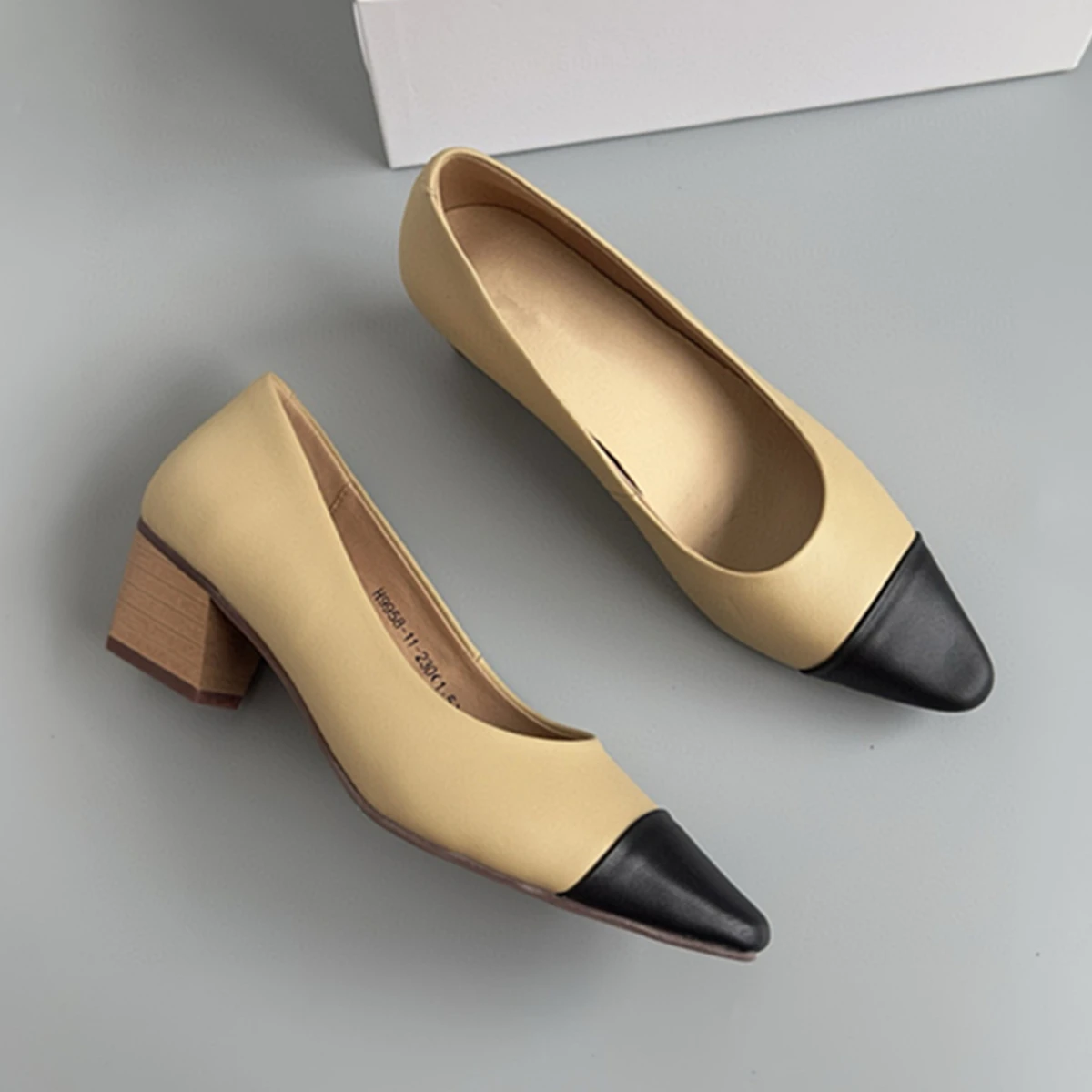
Square heel loafers excel in professional environments, offering a perfect blend of comfort and sophistication. These structured shoes convey authority and attention to detail—essential qualities in workplace dressing. The stable square heel provides confidence with every step, making them ideal for long days when you need to look as good as you feel.
When wearing loafers in office settings, pairing them with tailored trousers creates a polished, cohesive look. For maximum impact:
- Choose trouser lengths that break slightly at the shoe’s vamp
- Select pants with similar structure to complement the loafer’s clean lines
- Ensure color coordination between your loafers and other leather accessories
- Consider wider-leg trousers with higher square heels for balanced proportions
Square heel loafers also pair beautifully with professional dresses and skirts. When styling:
– Mid-length pencil skirts balance the substantial look of structured loafers
– A-line silhouettes complement the geometric nature of square heels
– Consider sheer hosiery in cooler months for a polished finish
– Maintain proportional balance—heavier loafers pair well with structured garments
Different industries may call for slight variations in styling. In creative environments, bolder colors and more distinctive square heel designs can express personality while maintaining professionalism. For more conservative workplaces, stick to classic dark leather with minimal embellishments. Business casual loafer outfits can incorporate subtle patterns or textures while maintaining a professional silhouette.
Accessorizing thoughtfully completes a professional square heel loafer look:
– Match leather belts to your loafers for visual cohesion
– Consider structured bags that echo the architectural quality of square heels
– Select metal jewelry that coordinates with any hardware on your loafers
– Keep hosiery subtle to maintain focus on your professional footwear
The right square heel height matters in professional settings—generally 1.5 to 2.5 inches provides elevation without sacrificing comfort during long workdays. Remember that darker colors and subtle finishes tend to read as more formal, making them excellent choices for workplace environments where traditional dress codes apply.
Casual Sophistication: Incorporating Square Heel Loafers into Everyday Style
Square heel loafers effortlessly elevate casual outfits beyond the ordinary. Their structured design brings instant polish to even the most relaxed ensembles, striking the perfect balance between comfort and style for everyday wear.
When pairing structured square heel loafers with jeans, consider how different silhouettes interact with your footwear:
- Straight-leg jeans: Cuff or crop to showcase the loafer’s details
- Wide-leg jeans: Choose a higher square heel to maintain balanced proportions
- Cropped jeans: Allow a small gap between hem and shoe to highlight the loafer’s shape
- Skinny jeans: Tuck in smoothly for a sleek silhouette that emphasizes the structured heel
For casual dresses and skirts, square heel loafers add unexpected sophistication:
– Mini skirts gain maturity when paired with structured loafers
– Midi skirts create a balanced silhouette with medium-height square heels
– Casual cotton dresses become more refined with the addition of leather square heel loafers
– Denim skirts take on a preppy sophistication when worn with structured loafers
Weekend outfit formulas that incorporate square heel loafers might include:
– Relaxed blazer + t-shirt + jeans + square heel loafers
– Oversized sweater + leggings + structured loafers
– Button-down shirt + chinos + penny loafers with square heels
– Casual jumpsuit + minimal square heel loafers
Each season offers opportunities to style square heel loafers differently. Spring calls for lighter colors and perhaps suede options with cropped pants. Summer welcomes loafers with linen separates or casual dresses. Fall is ideal for richer leather tones paired with layered outfits. Winter styling might incorporate loafers with socks and heavier fabrics.
The versatility of square heel loafers makes them perfect for casual settings where you want to appear put-together without seeming overdressed. Mastering professional loafers in casual contexts is about balancing their inherent structure with more relaxed garments. When styled thoughtfully, they elevate everyday looks while maintaining comfort and practicality.
Evening Elevation: Square Heel Loafers for Special Occasions
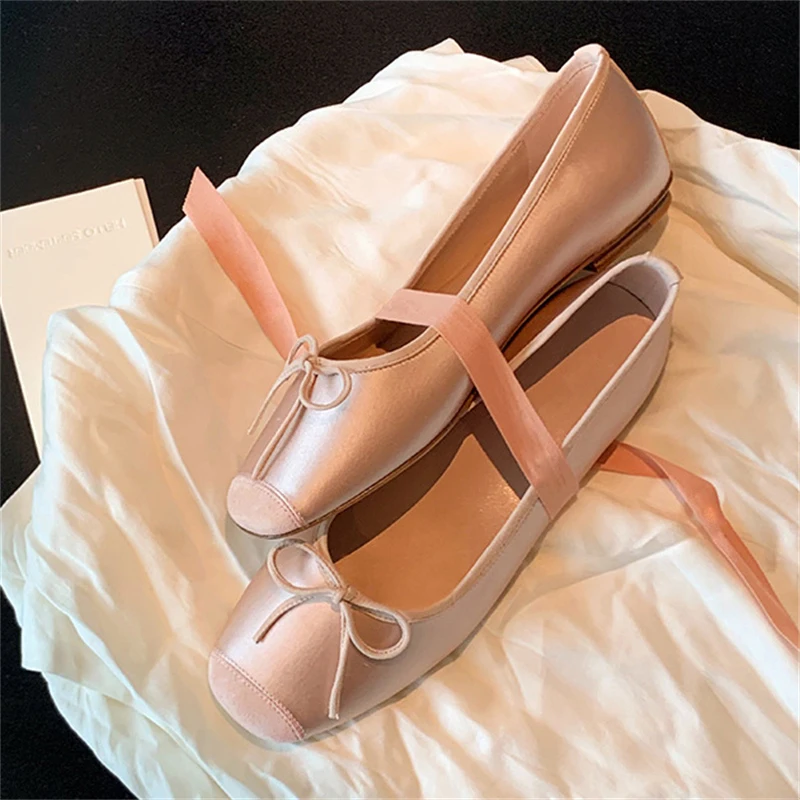
Square heel loafers aren’t limited to daytime wear—they can shine brilliantly for evening events with the right selection and styling. For special occasions, look for loafers with distinctive elements that elevate them beyond everyday styles:
- Rich materials like velvet, satin, or high-gloss patent leather
- Metallic finishes or subtle shimmer
- Decorative elements like crystal embellishments or jeweled hardware
- Deeper, more saturated colors or luxurious neutrals
- Higher square heels (2-3 inches) for added formality
When pairing structured square heel loafers with elegant jumpsuits and formal separates, proportion becomes crucial. The substantial nature of loafers balances beautifully with:
- Wide-leg silk or crepe jumpsuits that flow elegantly over the shoe
- Tailored tuxedo-style trousers with a perfect break at the vamp
- Sleek column dresses that create a continuous line with the architectural heel
- Midi-length skirts with subtle volume that counterbalances the loafer’s structure
Materials and finishes play a vital role in transitioning square heel loafers to evening wear. Patent leather offers sophisticated shine appropriate for formal settings. Velvet provides rich texture perfect for winter events. Metallic leathers catch the light beautifully for celebratory occasions. Embellished options with subtle crystals or pearls can even work for black-tie events when perfectly styled.
The question of whether loafers work for business professional settings extends to formal occasions as well. The answer lies in selecting block heel loafers with elegant details and pairing them thoughtfully with appropriate attire.
A significant advantage of choosing square heel loafers for evening events is their comfort advantage over traditional evening footwear. While stilettos might leave feet aching after an hour of standing, structured square heels distribute weight more evenly, allowing for comfortable movement throughout the event. This practical benefit needn’t come at the expense of style—today’s designer square heel loafers offer sophistication comparable to any formal shoe.
Seasonal Adaptation: Mastering Year-Round Styling with Structured Loafers
Square heel loafers can transition seamlessly through all seasons with thoughtful styling adaptations. Their versatility makes them valuable wardrobe investments that work year-round with minor adjustments.
For trans-seasonal styling between weather changes:
– Layer with thin socks as temperatures begin to drop
– Pair with cropped pants in changing seasons to balance proportions
– Opt for closed-toe loafers in neutral colors that work across seasons
– Select versatile leather finishes that look appropriate regardless of season
Incorporating socks, tights, and hosiery extends the wearability of square heel loafers:
– Thin trouser socks in coordinating colors for subtle warmth
– Textured tights that add visual interest in cooler months
– Statement socks in contrasting colors for creative casual looks
– Sheer hosiery for professional environments in transitional weather
The question of whether wearing loafers without socks is unprofessional depends largely on context and styling. In warmer months and casual settings, going sockless can be perfectly appropriate with square heel loafers, while professional environments might call for at least no-show sock options.
Layering techniques that showcase structured footwear include:
– Cropped hem lengths that highlight the loafer’s design details
– Rolled cuffs that create a deliberate break above the shoe
– Layered socks with shorter pants for stylish cold-weather looks
– Strategic color coordination between loafers and outer layers
Weather considerations require practical approaches:
– Apply protective sprays appropriate to your loafer’s material before seasonal changes
– Consider rubber sole options for wet weather conditions
– Rotate between multiple pairs to allow proper drying between wears
– Choose darker colors and more durable finishes for inclement weather
Adapting color choices seasonally keeps square heel loafers feeling current:
– Spring: Lighter neutrals, pastels, and soft metallics
– Summer: Brighter hues, white, or natural tan leathers
– Fall: Rich browns, burgundies, forest greens, and mustard tones
– Winter: Deep blacks, navy blues, and jewel tones
With these adaptations, one quality pair of structured square heel loafers can serve multiple purposes throughout the changing seasons.
Quality Indicators: A Buyer’s Guide to Identifying Well-Structured Square Heel Loafers
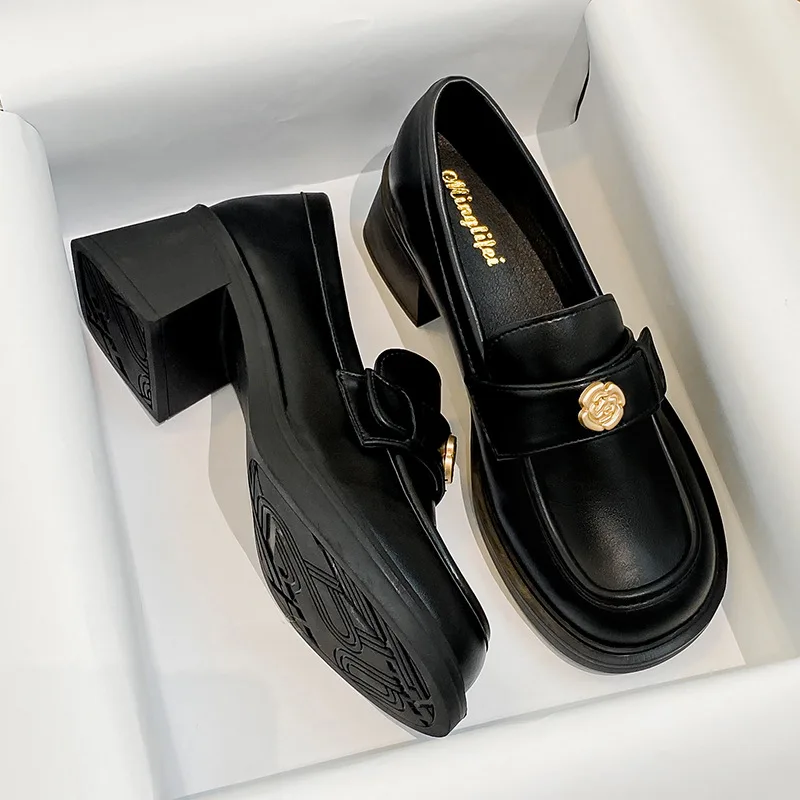
Investing in well-constructed square heel loafers requires understanding key quality indicators. This knowledge ensures your purchase delivers long-term value and performance.
Heel Construction Evaluation
– The heel should attach firmly with no visible gaps or excessive gluing
– Look for heels made from stacked leather or high-quality composites rather than hollow plastic
– Quality heels feature rubber caps or tips that can be replaced when worn
– The heel should align perfectly with the shoe’s center of gravity
– Higher-end loafers often have heels secured with both adhesive and nails/pins
Upper Material and Craftsmanship
– Examine stitching for evenness, with no loose threads or skipped stitches
– Quality leather shows natural variations rather than perfectly uniform appearance
– Edges should be neatly finished with no rough cuts or uneven dyes
– Pattern pieces should align precisely at seams
– Lining materials should feel smooth without bunching or wrinkling
Interior Comfort Features
– Look for padded insoles with proper arch support
– Quality loafers feature breathable lining materials
– Interior seams should be minimal and smoothly finished
– The footbed should be secured without wrinkles or bubbles
– Premium options often include memory foam or gel inserts at pressure points
Sole Construction and Attachment
– Blake-stitched or Goodyear-welted construction indicates quality
– Soles should be attached securely without excess glue visible
– Flexibility at the ball of the foot with structural rigidity in the arch
– Look for leather or high-quality rubber soles that show attention to detail
– The welt (where upper meets sole) should be clean and precisely finished
Corporate loafer guides often emphasize the importance of proper fit specific to structured styles. When trying on square heel loafers:
– Allow ¼ to ½ inch of space beyond your longest toe
– Ensure the widest part of your foot aligns with the widest part of the shoe
– The heel counter should hold your heel firmly without pinching
– Walk on hard surfaces to test stability and comfort
– Try on in the afternoon when feet are naturally larger
The price-quality relationship follows a general pattern, with heeled loafers in different brackets offering varying levels of quality:
– Entry-level ($50-150): Decent materials, simpler construction, fewer comfort features
– Mid-range ($150-300): Better materials, more refined construction, enhanced comfort features
– Premium ($300+): Highest quality materials, expert construction, superior comfort technologies and potential for resoling
Women's Comfortable Flat Loafers, Women's Leopard Print Loafers, Women's Low Heel Loafers
$82.50 Select options This product has multiple variants. The options may be chosen on the product pageWomen's Block Heel Loafers, Women's Heeled Penny Loafers, Women's Monk Strap Loafers
$194.04 Select options This product has multiple variants. The options may be chosen on the product pageWomen's Block Heel Loafers, Women's Square Heel Loafers, Women's Square Toe Flat Loafers
Price range: $73.61 through $86.41 Select options This product has multiple variants. The options may be chosen on the product pageWomen's Black Platform Loafers, Women's High Heel Loafers, Women's High Platform Loafers, Women's White Platform Loafers
$106.67 Select options This product has multiple variants. The options may be chosen on the product pageWomen's Black Flat Loafers, Women's Black Penny Loafers, Women's Classic Tassel Loafers
$194.28 Select options This product has multiple variants. The options may be chosen on the product pageWomen's Loafer Mules, Women's Suede Flat Loafers
$190.23 Select options This product has multiple variants. The options may be chosen on the product page
Understanding these quality indicators helps identify square heel loafers worth their investment—those that will maintain both structural integrity and style through years of wear.
Preserving Perfection: Essential Care for Structured Square Heel Loafers
Proper maintenance significantly extends the life and appearance of structured square heel loafers. Different materials require specific care approaches for optimal preservation.
Leather Care Essentials:
– Clean smooth leather with a soft, slightly damp cloth to remove surface dirt
– Apply quality leather conditioner every 1-2 months to prevent drying and cracking
– Use shoe trees between wears to maintain shape and absorb moisture
– Polish with matching color cream or wax polish to restore shine and protect surface
– Allow 24 hours of rest between wears with shoe trees inserted
Suede Care Techniques:
– Brush suede regularly with a dedicated suede brush to restore nap
– Use protective spray specifically formulated for suede before first wear
– Address stains immediately with a suede eraser or specialized cleaner
– Never use water or liquid cleaners directly on suede
– Store with cedar shoe trees wrapped in acid-free tissue to maintain shape
Patent Leather Maintenance:
– Wipe with a soft cloth dampened with water or mild soap solution
– Restore shine with specialized patent leather cleaner or petroleum jelly
– Avoid alcohol-based products which can damage the finish
– Clean promptly after wear to prevent buildup on high-shine surface
– Store away from direct heat sources which can cause cracking
Understanding the differences between leather versus suede loafer care helps preserve each material’s unique properties and appearance.
Proper Storage Techniques:
– Insert cedar shoe trees to maintain shape and absorb moisture
– Store in dust bags or boxes to protect from dust and light exposure
– Keep in a cool, dry place away from direct sunlight
– Never stack heavy items on top of loafers
– Allow proper air circulation to prevent mold or mildew
Preventative Care Strategies:
– Apply protective sprays appropriate to your loafer material before first wear
– Rotate between multiple pairs to extend the life of each
– Address scuffs and wear immediately before they worsen
– Check heel tips regularly and replace before they wear down to the heel base
– Keep leather conditioned to prevent cracking at flex points
Emergency Care Solutions:
– For water damage on leather: Dry naturally away from direct heat, then condition
– For salt stains: Clean promptly with a solution of water and white vinegar (1:1)
– For oil stains on suede: Apply cornstarch or talcum powder to absorb oil before brushing
– For scuffs on smooth leather: Use matching cream polish to restore color
– For heel damage: Seek professional repair before further wear damages the shoe structure
With consistent care tailored to your specific loafer materials, structured square heel loafers can maintain their beauty and functionality for many years of stylish wear.
The Evolution of an Icon: How Square Heel Loafers Became a Wardrobe Mainstay
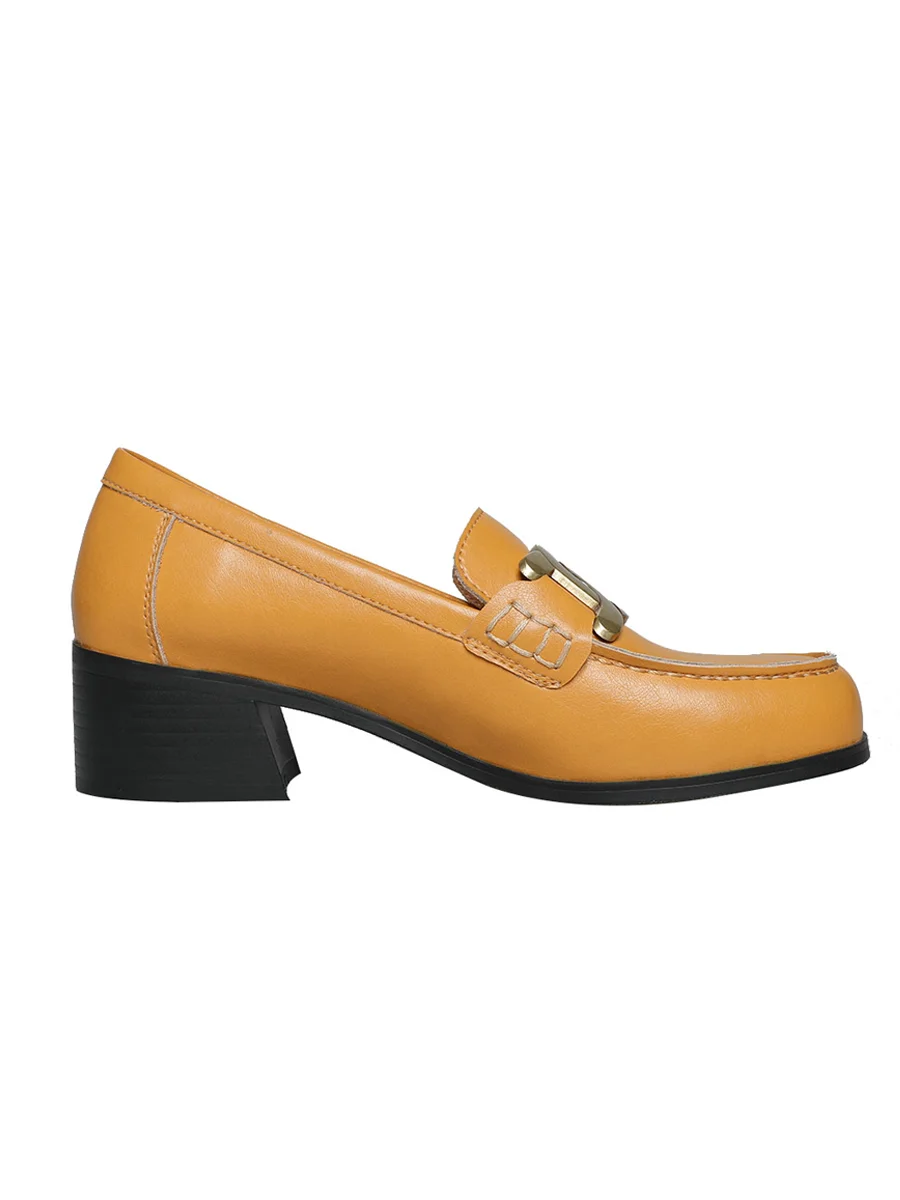
The journey of square heel loafers from casual footwear to versatile fashion staples reveals the remarkable adaptability of this design. Originally, loafers emerged as casual slip-on shoes designed for relaxed settings. Their early iterations lacked the structure and sophistication we associate with today’s versions. The transformation began when loafers migrated from purely leisure contexts into more diverse settings, gradually gaining acceptance in professional environments.
The introduction of structured square heels represented a significant innovation in loafer design. This architectural element brought several advantages: improved stability, enhanced posture support, and a more refined silhouette. The square heel provided a solid foundation that made loafers more suitable for all-day wear while maintaining their slip-on convenience. This practical improvement expanded their versatility dramatically.
Several pivotal fashion moments helped elevate square heel loafers to iconic status. Their adoption by influential style figures demonstrated their versatility across different aesthetics. The appearance of structured loafers in fashion magazines and on runways throughout the decades solidified their position as sophisticated options rather than merely casual alternatives. Their presence in workplace wardrobes also grew as professional footwear alternatives to traditional pumps gained acceptance.
Modern interpretations have continued to refresh the square heel loafer concept. Contemporary designers have experimented with proportions, introducing chunkier versions, platform adaptations, and various heel heights while maintaining the distinctive square shape. Material innovations have expanded options beyond traditional leathers to include sustainable alternatives, technical fabrics, and creative textures. Hardware and embellishment variations have transformed the once-simple loafer into a vehicle for creative expression.
Several factors contribute to the enduring appeal of structured square heel loafers:
- Their perfect balance of comfort and sophistication
- The versatility to transition between different dress codes
- Their ability to adapt to changing fashion trends while maintaining core design elements
- The practical advantages of stability and support
- Their gender-fluid styling potential in contemporary fashion
This evolution demonstrates how thoughtful design improvements can transform a basic concept into an enduring wardrobe essential that continues to feel relevant decade after decade.
Frequently Asked Questions About Square Heel Loafers with Structure
Are square heel loafers comfortable for walking all day?
Yes, well-designed square heel loafers can be exceptionally comfortable for all-day wear. Their broader heel base distributes weight more evenly than narrower heels, reducing pressure on any single point of the foot. Look for options with cushioned insoles, proper arch support, and heel heights between 1-2 inches for maximum walking comfort. Quality materials that mold to your foot over time also enhance long-term comfort. However, like any shoe, proper fit is essential—too tight or too loose loafers will cause discomfort regardless of their structural benefits.
How do I know if a square heel loafer has good structure?
Quality structured loafers will feel substantial and hold their shape firmly when examined. Check that the heel counter (back of the shoe) maintains its rigidity when pressed. The shoe should not collapse or fold excessively when held at both ends and gently twisted. Examine the interior for visible support elements like reinforced arches or cushioned insoles. The heel should attach securely with no movement or gaps. Quality structured loafers often feel slightly heavier than poorly constructed alternatives due to their reinforcement elements and superior materials.
What heel height is best for comfort in square heel loafers?
Most people find square heel loafers with heights between 1-2 inches provide the optimal balance of comfort and style for everyday wear. This moderate height offers slight elevation without shifting too much weight onto the ball of the foot. For those prioritizing maximum comfort, low heel loafers (0.5-1.5 inches) provide stability with minimal foot angle. Those seeking more dramatic style might choose 2-3 inch heels for shorter wear periods. The ideal height ultimately depends on your comfort threshold, but the squared shape generally makes higher heels more manageable than pointed styles.
Can square heel loafers be worn in formal settings?
Square heel loafers can certainly work in many formal settings when selected and styled appropriately. For formal occasions, choose loafers in high-quality materials like polished leather or elegant suede. Minimal embellishments or refined hardware (like a subtle horsebit) maintain sophistication. Darker colors traditionally read as more formal, with black patent options suitable for even black-tie events when styled impeccably. The key to wearing professional loafers in formal settings is ensuring immaculate condition, appropriate shine, and complementary formal attire.
How do I style square heel loafers with socks?
Styling square heel loafers with socks offers both practical warmth and fashion versatility. For professional settings, choose thin trouser socks in colors that match either your loafers or your outfit for a cohesive look. In casual settings, you can experiment with textured socks, subtle patterns, or even statement colors that complement your overall palette. Length-wise, crew socks work well with pants, while ankle socks pair nicely with cropped styles. The thickness of your socks may affect fit, so you might need to size up slightly if you plan to wear thicker socks regularly with your loafers.
What’s the difference between a block heel and a square heel?
While often used interchangeably, there are subtle distinctions between block heels and square heels. Block heels typically refer to any heel with substantial width throughout, creating a “block-like” appearance when viewed from the side. Square heels specifically feature a squared-off geometric shape when viewed from behind or below, with right angles and parallel sides. All square heels are block heels, but not all block heels are square—some may have rounded edges or taper slightly while still maintaining substantial width. Square heels tend to have a more architectural, geometric appearance that creates a distinctive visual statement.
How do I break in structured loafers comfortably?
Breaking in structured square heel loafers requires patience to avoid discomfort:
1. Wear them initially for 1-2 hours at home on carpet
2. Use bandages on potential pressure points preventatively
3. Apply leather conditioner to soften leather uppers
4. Insert shoe trees between wears to maintain shape while stretching slightly
5. Consider professional stretching for problem areas
6. Gradually increase wearing time before committing to full days
7. Use thin socks initially to reduce friction until the shoe conforms to your foot
Can I replace the heel on my square heel loafers?
Yes, quality square heel loafers can typically have their heels replaced by a skilled cobbler. This repair extends the life of well-made shoes significantly. Rubber heel caps or tips usually wear down first and are the easiest to replace. Full heel replacement is more complex but possible if the upper is still in good condition. Higher quality loafers with Goodyear welted or Blake stitched construction are most suitable for heel replacement. For investment-quality loafers, maintaining the heels through prompt replacement when worn prolongs their lifespan substantially and represents good value over time.

